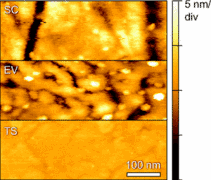Optical dielectric function of gold
| Reviews and Highlights | Quantum Science | Molecular and Soft-matter | Ultrafast Nano-optics and Nanophotonics | Mineralogy and Geochemistry |
|---|
Robert L. Olmon, Brian Slovick, Timothy W. Johnson, David Shelton, Sang-Hyun Oh, Glenn D. Boreman, and Markus B. Raschke
Phys. Rev. B 86, 235147 (2012).
DOI PDF

In metal optics gold assumes a special status because of its practical importance in optoelectronic and nano- optical devices, and its role as a model system for the study of the elementary electronic excitations that underlie the interaction of electromagnetic fields with metals. However, largely inconsistent values for the frequency dependence of the dielectric function describing the optical response of gold are found in the literature. We performed precise spectroscopic ellipsometry measurements on evaporated gold, template-stripped gold, and single-crystal gold to determine the optical dielectric function across a broad spectral range from 300 nm to 25 μm (0.05-4.14 eV) with high spectral resolution. We fit the data to the Drude free-electron model, with an electron relaxation time τD =14+/-3 fs and plasma energy hbar*ωp=8.45eV. We find that the variation in dielectric functions for the different types of samples is small compared to the range of values reported in the literature. Our values, however, are comparable to the aggregate mean of the collection of previous measurements from over the past six decades. This suggests that although some variation can be attributed to surface morphology, the past measurements using different approaches seem to have been plagued more by systematic errors than previously assumed.
Data: Au_dielectric_Evaporated_01.dat, Au_dielectric_Single_crystal_01.dat, Au_dielectric_Template_stripped_01.dat
